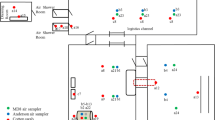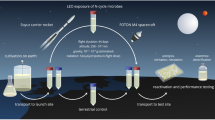Abstract
Exposure to radiation and due to the microgravity in outer space, alterations of the gene expression of microorganisms have been reported, making them more virulent and enhancing their degradation capabilities. In the present study, cellulose-degrading microbes were isolated from China’s space station assembly clean room (CSSAC). They then were sent for a short space flight of 16 h by Long March 7 carrier rocket (space sample). At the same time, the microflora was tested on the ground as a control experiment (earth sample). Interestingly, the quantities of β-endoglucanase and total extracellular proteins were found significantly increased in the space sample, which resulted in increased cellulose degradation ability and changes in the structure of microbial flora. After identification, the culturable cellulose-degrading bacteria in the space sample is Bacillus sp. Y (M234399). Two different Fusarium strains were isolated from both samples and Trichoderma sp. S3 was isolated only from the space sample. Clone library results revealed that Escherichia, Shigella, and Salmonella were found in both samples and Shigella sp. B17 was found only in the space sample. Fusarium was also found in both samples, but they do not belong to the same species. Mutation studies revealed no changes in the endoglucanase gene. Still, enhanced growth of the strains from space samples was observed in Scanning Electron Microscopy (SEM) results along with upregulation of cellulase gene. This study confirmed the presence of cellulolytic microbes and increased celluolytic activity after short space flight, so, in the future, more care should be given while designing spacesuits and astronauts' belongings.








Similar content being viewed by others
References
Alekhova TA, Aleksandrova AA, Novozhilova TY et al (2005) Monitoring of microbial degraders in manned space stations. Appl Biochem Microbiol 41:435–443. https://doi.org/10.1007/s10438-005-0065-x
Alekhova TA, Zagustina NA, Aleksandrova VA et al (2007) Monitoring of initial stages of the biodamage of construction materials used in aerospace equipment using electron microscopy. J Surf Investig. https://doi.org/10.1134/S102745100704009X
Alekhova TA, Aleksandrova AV, Novozhilova TY et al (2008) The experiment “initial stages of biological damage and deterioration in space.” Mosc Univ Biol Sci Bull 63:163–169
Alekhova TA, Shklover VY, Zagustina NA et al (2010) Electron microscopy investigation of AlMg6 aluminum alloy surface defects caused by microorganisms extracted in space stations. J Surf Investig 4:747–753. https://doi.org/10.1134/S1027451010050083
Alekhova TA, Zakharchuk LM, Tatarinova NY et al (2015) Diversity of bacteria of the genus Bacillus on board of international space station. Dokl Biochem Biophys 465:347–350. https://doi.org/10.1134/S1607672915060010
Arunasri K, Adil M, Venu Charan K et al (2013) Effect of simulated microgravity on E. coli K12 MG1655 growth and gene expression. PLoS ONE 8:e57860. https://doi.org/10.1371/journal.pone.0057860
Aunins TR, Erickson KE, Prasad N et al (2018) Spaceflight modifies Escherichia coli gene expression in response to antibiotic exposure and reveals role of oxidative stress response. Front Microbiol 16:310. https://doi.org/10.3389/fmicb.2018.00310
Bashir M, Ahmed M, Weinmaier T et al (2016) Functional metagenomics of spacecraft assembly cleanrooms: presence of virulence factors associated with human pathogens. Front Microbiol 7:1321. https://doi.org/10.3389/fmicb.2016.01321
Behera BC, Sethi BK, Mishra RR et al (2017) Microbial cellulases – Diversity & biotechnology with reference to mangrove environment: a review. J Genet Eng Biotechnol 15:197–210. https://doi.org/10.1016/j.jgeb.2016.12.001
Bell TE (2007) Preventing “Sick” Spaceships | Science Mission Directorate. Washington, DC
Bijlani S, Stephens E, Singh NK et al (2021) Advances in space microbiology. iScience 24:102395. https://doi.org/10.1016/j.isci.2021.102395
Checinska A, Probst AJ, Vaishampayan P et al (2015) Microbiomes of the dust particles collected from the International Space Station and Spacecraft Assembly Facilities. Microbiome 3:50. https://doi.org/10.1186/s40168-015-0116-3
Cohrs RJ, Mehta SK, Schmid DS et al (2008) Asymptomatic reactivation and shed of infectious varicella zoster virus in astronauts. J Med Virol 80:1116–1122. https://doi.org/10.1002/jmv.21173
Crabbé A, Nielsen-Preiss SM, Woolley CM et al (2013) Spaceflight enhances cell aggregation and random budding in Candida albicans. PLoS ONE. https://doi.org/10.1371/journal.pone.0080677
Crabbé A, Pycke B, Van Houdt R et al (2010) Response of pseudomonas aeruginosa PAO1 to low shear modelled microgravity involves AlgU regulation. Environ Microbiol 12:1545–1564. https://doi.org/10.1111/j.1462-2920.2010.02184.x
Fujiwara D, Kawaguchi Y, Kinoshita I et al (2021) Mutation analysis of the rpoB gene in the radiation-resistant bacterium deinococcus radiodurans R1 exposed to space during the Tanpopo experiment at the International Space Station. Astrobiology. https://doi.org/10.1089/ast.2020.2424
Ghose TK (1987) Measurement of cellulase activities. Pure Appl Chem 59:257–268. https://doi.org/10.1351/pac198759020257
Ghosh S, Osman S, Vaishampayan P, Venkateswaran K (2010) Recurrent isolation of extremotolerant bacteria from the clean room where phoenix spacecraft components were assembled. Astrobiology 10:325–335. https://doi.org/10.1089/ast.2009.0396
Gordon TR (2017) Fusarium oxysporum and the fusarium wilt syndrome. Annu Rev Phytopathol 55:23–39. https://doi.org/10.1146/annurev-phyto-080615-095919
Guarro J, Gené J (1995) Opportunistic fusarial infections in humans. Eur J Clin Microbiol Infect Dis 14:741–754. https://doi.org/10.1007/BF01690988
Gueguinou N, Huin-Schohn C, Bascove M et al (2009) Could spaceflight-associated immune system weakening preclude the expansion of human presence beyond Earth’s orbit? J Leukoc Biol 86:1027–1038. https://doi.org/10.1189/jlb.0309167
Gupta P, Samant K, Sahu A (2012) Isolation of cellulose-degrading bacteria and determination of their cellulolytic potential. Int J Microbiol. https://doi.org/10.1155/2012/578925
Heijs SK, Haese RR, van der Wielen PWJJ et al (2007) Use of 16S rRNA gene based clone libraries to assess microbial communities potentially involved in anaerobic methane oxidation in a Mediterranean cold seep. Microb Ecol 53:384–398. https://doi.org/10.1007/s00248-006-9172-3
Horneck G, Klaus DM, Mancinelli RL (2010) Space microbiology. Microbiol Mol Biol Rev 74:121–156. https://doi.org/10.1128/mmbr.00016-09
Kacena MA, Merrell GA, Manfredi B et al (1999) Bacterial growth in space flight: logistic growth curve parameters for Escherichia coli and Bacillus subtilis. Appl Microbiol Biotechnol 51:229–234. https://doi.org/10.1007/s002530051386
Kim W, Tengra FK, Shong J et al (2013) Effect of spaceflight on Pseudomonas aeruginosa final cell density is modulated by nutrient and oxygen availability. BMC Microbiol. https://doi.org/10.1186/1471-2180-13-241
Klintworth R, Reher HJ, Viktorov AN, Bohle D (1999) Biological induced corrosion of materials II: new test methods and experiences from MIR station. Acta Astronaut 44:569–578. https://doi.org/10.1016/S0094-5765(99)00069-7
Koskinen K, Rettberg P, Pukall R et al (2017) Microbial biodiversity assessment of the European Space Agency’s ExoMars 2016 mission. Microbiome 5:143. https://doi.org/10.1186/s40168-017-0358-3
La Duc MT, Dekas A, Osman S et al (2007) Isolation and characterization of bacteria capable of tolerating the extreme conditions of clean room environments. Appl Environ Microbiol 73:2600–2611. https://doi.org/10.1128/AEM.03007-06
La Duc MT, Venkateswaran K, Conley CA (2014) A genetic inventory of spacecraft and associated surfaces. Astrobiology 14:15–23. https://doi.org/10.1089/ast.2013.0966
Legodi LM, La Grange D, Van Rensburg ELJ, Ncube I (2019) Isolation of cellulose degrading fungi from Decaying Banana Pseudostem and Strelitzia alba. Enzyme Res. https://doi.org/10.1155/2019/1390890
Mahoney E (2017) Spacewalk spacesuit basics. https://www.nasa.gov/feature/spacewalk-spacesuit-basics. Accessed 1 Jan 2020
Mehta SK, Stowe RP, Feiveson AH et al (2000) Reactivation and shedding of cytomegalovirus in astronauts during spaceflight. J Infect Dis 182:1761–1764. https://doi.org/10.1086/317624
Moissl C, Osman S, La Duc MT et al (2007) Molecular bacterial community analysis of clean rooms where spacecraft are assembled. FEMS Microbiol Ecol 61:509–521. https://doi.org/10.1111/j.1574-6941.2007.00360
Newcombe D, Dekas A, Mayilraj S, Venkateswaran K (2009) Bacillus canaveralius sp. nov., an alkali-tolerant bacterium isolated from a spacecraft assembly facility. Int J Syst Evol Microbiol. https://doi.org/10.1099/ijs.0.009167-0
Nickerson CA, Ott CM, Wilson JW et al (2004) Microbial responses to microgravity and other low-shear environments. Microbiol Mol Biol Rev MMBR 68:345–361. https://doi.org/10.1128/MMBR.68.2.345-361.2004
Novikova N, De Boever P, Poddubko S et al (2006) Survey of environmental biocontamination on board the International Space Station. In: Research in microbiology. pp 5–12
O’Donnell K, Sutton DA, Rinaldi MG et al (2004) Genetic diversity of human pathogenic members of the Fusarium oxysporum complex inferred from multilocus DNA sequence data and amplified fragment length polymorphism analyses: evidence for the recent dispersion of a geographically widespread clonal lineag. J Clin Microbiol 42:5109–5120. https://doi.org/10.1128/JCM.42.11.5109-5120.2004
Orlovska I, Podolich O, Kukharenko O et al (2021) Bacterial cellulose retains robustness but its synthesis declines after exposure to a mars-like environment simulated outside the International Space Station. Astrobiology. https://doi.org/10.1089/ast.2020.2332
Pfaffl MW (2001) A new mathematical model for relative quantification in real-time RT-PCR. Nucleic Acids Res. https://doi.org/10.1093/nar/29.9.e45
Pierson DL, Stowe RP, Phillips TM et al (2005) Epstein-Barr virus shedding by astronauts during space flight. Brain Behav Immun 19:235–242. https://doi.org/10.1016/j.bbi.2004.08.001
Reddy KV, Lakshmi TV, Reddy AVK et al (2016) Isolation, screening, identification and optimized production of extracellular cellulase from Bacillus subtilis Sub.sps using cellulosic waste as carbon source. Int J Curr Microbiol Appl Sci. https://doi.org/10.20546/ijcmas.2016.504.052
Sazci A, Erenler K, Radford A (1986) Detection of cellulolytic fungi by using Congo red as an indicator: a comparative study with the dinitrosalicyclic acid reagent method. J Appl Microbiol 61:559–562. https://doi.org/10.1111/j.1365-2672.1986.tb01729.x
Singh NK, Wood JM, Karouia F, Venkateswaran K (2018) Succession and persistence of microbial communities and antimicrobial resistance genes associated with International Space Station environmental surfaces. Microbiome 6:204. https://doi.org/10.1186/s40168-018-0585-2
Sobisch LY, Rogowski KM, Fuchs J et al (2019) Biofilm forming antibiotic resistant gram-positive pathogens isolated from surfaces on the international space station. Front Microbiol 10:1–16. https://doi.org/10.3389/fmicb.2019.00543
Sow NM, Dauphin RD, Roblain D et al (2005) Polyphasic identification of a new thermotolerant species of lactic acid bacteria isolated from chicken faeces. Afr J Biotechnol 4:409–421. https://doi.org/10.4314/ajb.v4i5.15116
Taylor GR (1974) Space microbiology. Annu Rev Microbiol 28:121–137. https://doi.org/10.1146/annurev.mi.28.100174.001005
Taylor PW (2015) Impact of space flight on bacterial virulence and antibiotic susceptibility. Infect Drug Resist 8:249–262. https://doi.org/10.2147/IDR.S67275
Tirumalai MR, Karouia F, Tran Q et al (2017) The adaptation of Escherichia coli cells grown in simulated microgravity for an extended period is both phenotypic and genomic. Npj Microgravity. https://doi.org/10.1038/s41526-017-0020-1
Tucker DL, Ott CM, Huff S et al (2007) Characterization of Escherichia coli MG1655 grown in a low-shear modeled microgravity environment. BMC Microbiol. https://doi.org/10.1186/1471-2180-7-15
Urbaniak C, Massa G, Hummerick M et al (2018) Draft genome sequences of two Fusarium oxysporum isolates cultured from infected Zinnia hybrida plants grown on the International Space Station. Genome Announc 6:e00326-e418. https://doi.org/10.1128/genomeA.00326-18
White T, Bruns T, Lee S, Taylor J (1990) Amplification and direct sequencing of fungal ribosomal RNA genes for phylogenetics. Academic Press Inc, New York
Wilson JW, Ott CM, Hö Ner Zu Bentrup K et al (2007) Space flight alters bacterial gene expression and virulence and reveals a role for global regulator Hfq
Zhang Y, Zhang L, Li Z et al (2019) Microbiomes of China’s Space Station during assembly, integration, and test operations. Microb Ecol 78:631–650. https://doi.org/10.1007/s00248-019-01344-4
Zhang Y, Xin C, Wang X, Deng Y-L (2020) Detection of microorganism from China’s spacecraft assembly cleanroom. Acta Astronaut 166:545–547. https://doi.org/10.1016/j.actaastro.2018.08.024
Acknowledgments
We thank China’s space station assembly cleanroom staff, Tianjin, for their cooperation, which helped us collect samples for our research.
Funding
This work was supported by the National Natural Science Foundation of China (NSFC), under grant No. 31600404, and Space Station Engineering and aerospace technology test field project. Author Ying Zhang received both the research supports.
Author information
Authors and Affiliations
Contributions
All authors contributed to the study's conception and design. Yasmeen Shakir performed material preparation and data collection and analysis. Yasmeen Shakir wrote the first draft of the manuscript. Nino Rcheulishvili helped in experimental procedures. Ying Zhang designed the experiment, guided the experimental method, and received funding. Yulin Deng supervised the overall research and assisted in the short-term space flight and sample collection. All authors read and approved the final manuscript.
Corresponding authors
Ethics declarations
Conflict of interest
This work was done in the absence of any commercial or financial interest.
Ethical Approval
This is an observational study. The Beijing Institute of Technology Research & Ethics Committee confirmed that no ethical approval is required.
Additional information
Publisher's Note
Springer Nature remains neutral with regard to jurisdictional claims in published maps and institutional affiliations.
Supplementary Information
Below is the link to the electronic supplementary material.
S 1 a. Cellulose degrading consortia were inoculated into centrifuge tubes b. Centrifuge tubes were packed in a self-made instrument and has not been closed. c. Photos of self-made instruments carrying cellulose degrading consortium before loading into the cabin.
S 2. Rarefaction curves for (a). 16S rRNA gene libraries of space and earth sample and (b). ITS partial gene sequences of space and earth sample.
Rights and permissions
About this article
Cite this article
Shakir, Y., Rcheulishvili, N., Zhang, Y. et al. Effects of short-term space conditions on cellulose degradation ability and biodiversity of microorganisms. Cellulose 29, 5061–5077 (2022). https://doi.org/10.1007/s10570-022-04574-x
Received:
Accepted:
Published:
Issue Date:
DOI: https://doi.org/10.1007/s10570-022-04574-x




